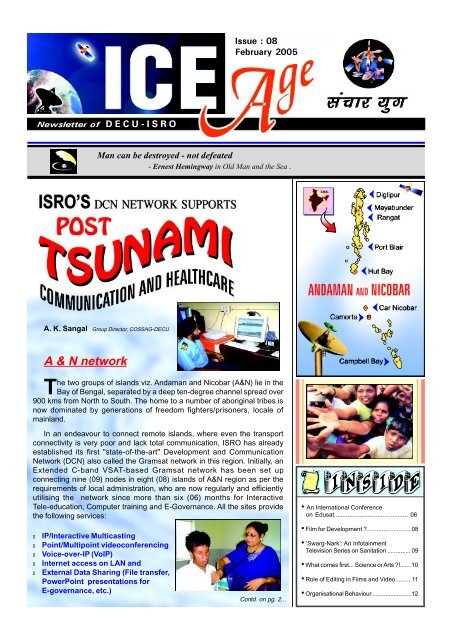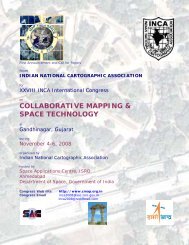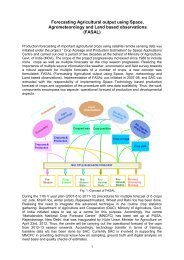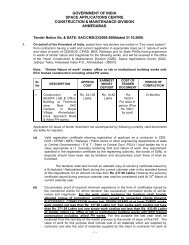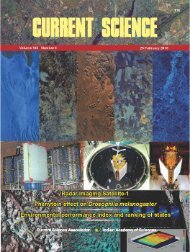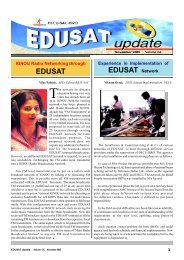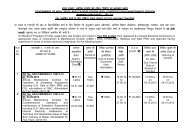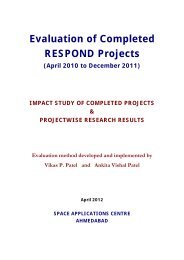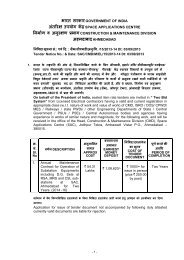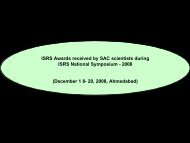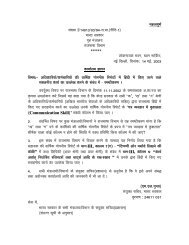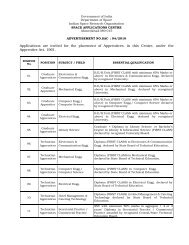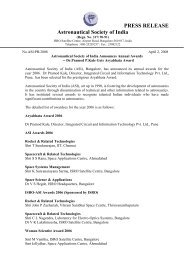Download PDF - Space Applications Centre
Download PDF - Space Applications Centre
Download PDF - Space Applications Centre
Create successful ePaper yourself
Turn your PDF publications into a flip-book with our unique Google optimized e-Paper software.
Issue : 08<br />
February 2005<br />
Newsletter of D E C U - I S R O<br />
Man can be destroyed - not defeated<br />
- Ernest Hemingway in Old Man and the Sea .<br />
A. K. Sangal Group Director, COSSAG-DECU<br />
A & N network<br />
The two groups of islands viz. Andaman and Nicobar (A&N) lie in the<br />
Bay of Bengal, separated by a deep ten-degree channel spread over<br />
900 kms from North to South. The home to a number of aboriginal tribes is<br />
now dominated by generations of freedom fighters/prisoners, locale of<br />
mainland.<br />
In an endeavour to connect remote islands, where even the transport<br />
connectivity is very poor and lack total communication, ISRO has already<br />
established its first "state-of-the-art" Development and Communication<br />
Network (DCN) also called the Gramsat network in this region. Initially, an<br />
Extended C-band VSAT-based Gramsat network has been set up<br />
connecting nine (09) nodes in eight (08) islands of A&N region as per the<br />
requirements of local administration, who are now regularly and efficiently<br />
utilising the network since more than six (06) months for Interactive<br />
Tele-education, Computer training and E-Governance. All the sites provide<br />
the following services:<br />
• An International Conference<br />
on Edusat............................................ 06<br />
IP/Interactive Multicasting<br />
Point/Multipoint videoconferencing<br />
Voice-over-IP (VoIP)<br />
Internet access on LAN and<br />
External Data Sharing (File transfer,<br />
PowerPoint presentations for<br />
E-governance, etc.)<br />
Contd. on pg. 2...<br />
• Film for Development ?.......................... 08<br />
• ‘Swarg-Nark’: An Infotainment<br />
Television Series on Sanitation .............. 09<br />
• What comes first... Science or Arts ?!.......10<br />
• Role of Editing in Films and Video......... 11<br />
• Organisational Behaviour ........................12
Contd. from pg. 1...<br />
The network has been used regularly for 20 days and<br />
8 Hrs per day for Education, Internet, E-governance, etc.<br />
Under Telemedicine project, ISRO had also established<br />
three (03) telemedicine nodes, of which two are at Port<br />
Blair namely GB Pant hospital and Navy hospital,<br />
Dhanavantari and the third one i.e. Richardson hospital at<br />
Car Nicobar. Regular telemedicine consultations are held<br />
amongst each other and as well as with the specialist<br />
centres on mainland.<br />
Tsunami Disaster<br />
Unfortunately on 26th December 2004, the worst-ever<br />
natural disaster in India, the TSUNAMI, has mainly<br />
affected the entire A&N region of the country. More than<br />
5,000 people were killed, several hundreds injured, got<br />
uprooted, displaced and stranded nowhere to go. Still more<br />
than 3000 people are missing. Many of them had to<br />
abandon their homes and were ferried to much safer<br />
islands. Infrastructure and property worth several crores<br />
of rupees was damaged/destroyed. A beautiful tourist place<br />
once upon a time has become a sight of destruction on<br />
number of islands. The coastline of number of islands has<br />
changed by more than 0.5 KM.<br />
All the islands of A&N region were badly affected by<br />
Tsunami. The island named Hutbay to a great extent was<br />
submerged under water including the ISRO node and its<br />
hardware. The maximum affected island is Car Nicobar<br />
where the ISRO installation was totally washed off,<br />
leaving no trace of even the VSAT antenna. One of the<br />
islands namely, Kamorta (Nancowry) was saved because<br />
of the obstruction by the Trinket Island.<br />
Post Tsunami Support<br />
Soon after Tsunami, the destructed areas were left with<br />
disrupted communication links. The more affected remote<br />
islands were not only de-linked with rest of the world due to<br />
lack of communication support but also due to discontinued<br />
commutation by ships owing to fear of recurring Tsunami<br />
effects. This is when the ISRO satellite communication<br />
systems came to rescue in providing sustained communication<br />
support for rehabilitation activities and healthcare.<br />
Some efforts for the Tsunami affected people included:<br />
Identification/Communication to near & dear ones<br />
Administrative support through<br />
videoconferencing<br />
Data transfer like death toll, list of survivors,<br />
relief material supply information viz. food,<br />
clothes, medicine, etc.<br />
Telemedicine<br />
Internet access<br />
By 27th of December, 2004 a gateway was established<br />
at ISRO Ahmedabad, which was temporarily configured in<br />
Closed User Group (CUG) of A&N DCN network to provide<br />
audio, video and data connectivity from main land by<br />
interfacing ISDN line and BSNL telephone exchange. This<br />
node was used to provide communication support, network<br />
monitoring, as well as multi-point videoconferencing for<br />
health care support to remote patients of A&N from the<br />
Doctors/specialists of Gujarat. Also, a high-level technical<br />
team of ISRO was sent to A&N islands to restore the<br />
damaged systems to the extent possible. The systems of<br />
Mayabunder node were shifted to Hutbay node, as the<br />
communication support required there was more important.<br />
Contd. on pg. 3...<br />
2 ICE Age DECU - ISRO
Contd. from pg. 2...<br />
Since the Nicobar Islands region was most affected, it<br />
was required to configure the existing DCN network nodes<br />
to connect PHCs also for telemedicine purposes. As a<br />
first step, it was planned to immediately set-up two (2)<br />
Telemedicine nodes at Campbell bay and Kamorta<br />
(Nancowry). A DECU technical team was sent to establish<br />
telemedicine links to Primary Health <strong>Centre</strong>s (PHC) of<br />
Campbell bay and Kamorta. To provide connectivity, the<br />
Gramsat (DCN) node of Campbell bay was extended to<br />
the PHC, Campbell bay located at a distance of about 2KM,<br />
through a LAN extender SDSL modem. Similar configuration<br />
has been implemented at Kamorta. In due course of<br />
time, it is planned to provide telemedicine connectivity<br />
to about 24 more PHC's throughout the A&N region.<br />
All these patient nodes will be connected to the specialist<br />
hospital i.e. GB Pant Hospital, Port Blair. Further 10 more<br />
Islands will be provided with the DCN nodes.<br />
region. According to the chief of local administration, about<br />
2000 people could communicate with their near and dear<br />
on their well being from these remote islands during first<br />
15 days. Till date support to more than 6000 people has<br />
been provided.Relief commissioners and heads of<br />
various departments also used this effectively to assess<br />
the quantum of damage that has taken place in the<br />
disaster.<br />
The network was utilised round the clock and was<br />
operated 24 hours for 1-½ months post Tsunami, to<br />
provide communication to near and dear located in Nicobar<br />
Contd. on pg. 3...<br />
ICE Age DECU - ISRO<br />
3
Contd. from pg. 3...<br />
Medical advises were regularly<br />
given to heavily devastated Car<br />
Nicobar islands through Telemedicine<br />
VSAT installation at this island<br />
from GB pant hospital Port Blair.<br />
During his scheduled visit to<br />
A&N islands to monitor relief and<br />
rehabilitation activities, the Hon'ble<br />
Minister of Home Affairs, also visited<br />
the telemedicine node at PHC,<br />
Campbell bay and had an online<br />
interaction with specialist doctors<br />
of Port Blair hospital through<br />
videoconferencing. It maybe noted<br />
that Campbell Bay PHC is the<br />
farthest and remotest PHC of the<br />
country. Transfer of medical data and<br />
online ECG was also demonstrated<br />
to the hon'ble minister. The hon'ble<br />
minister acclaimed the efforts put in<br />
jointly by ISRO and local administration and also suggested speedy implementation of similar systems throughout the<br />
region at the earliest.<br />
At some nodes, the facility of Internet access was the only means of communication to local public. Also some task<br />
teams working on relief and rehabilitation activities like the NGO's, Private relief activists, etc. had been using it since<br />
Tsunami.<br />
A word about the survivor - "He is alright" through ISRO network brought back life to his family according to<br />
press.<br />
The timely efforts in A&N islands by ISRO has proved how a Development Communication Network can be readily<br />
configured to support emergencies and post disasters communication through ISRO space systems.<br />
CARTOON By Tushar Tapodhan<br />
“<br />
My brother was in Kondul. He was posted there as Police Wireless<br />
Operator and after 26th Dec. we did not have any communication.<br />
On 29th we came to know that rescue team has brought all<br />
the survivors from Kondul to C/Bay and because of this DCN all<br />
were very optimistic to know about thier survival. From the screen,<br />
one word of the operator from Campbell Bay that, “he is all right”<br />
had brought back life in my family. Survival and life was more<br />
important than anything else, for the crowd waiting to know about<br />
there nears and dears.<br />
”<br />
- One of the relatives of the rescued persons<br />
○ ○ ○ ○ ○ ○ ○ ○ ○ ○ ○ ○ ○ ○ ○ ○ ○ ○ ○ ○ ○ ○ ○ ○ ○ ○ ○ ○ ○ ○ ○ ○ ○ ○ ○ ○ ○ ○ ○<br />
○ ○ ○ ○ ○ ○ ○ ○ ○ ○ ○ ○ ○ ○ ○ ○ ○ ○ ○ ○ ○ ○ ○ ○ ○ ○ ○ ○ ○ ○ ○ ○ ○ ○ ○ ○ ○ ○ ○<br />
4 ICE Age DECU - ISRO
ICE Age DECU - ISRO<br />
5
Forging International Partnerships in use of Multimedia for Education through EDUSAT<br />
In the context of preparations for EDUSAT, Commonwealth of Learning (COL) and ISRO have come together to<br />
provide a platform for about 50 senior educators and administrators from the developing Commonwealth countries of<br />
Africa and Asia to benchmark practices and develop partnerships in the use of technology for education at an International<br />
"Participants at the conference are spending two days to share experience and good practices among African and<br />
Asian Countries' educators; explore and examine global standards in both technical and content development aspects of<br />
using technology in education; synergize and develop potential South-South partnerships and develop a model incorporating<br />
the core principles of good practice. The conference was inaugurated by Prof. Gajaraj Dhanarajan, former President and<br />
CEO,Commonwealth of Learning. Prof. Ravindra Dave, former Director, International Institute of Education, UNESCO was<br />
the guest of honour and Prof. Rajasekharan Pillai presided over the function. Dr. K.N. Shankara, Director SAC gave an<br />
overview of the Indian situation while Mr. B.S. Bhatia, Director, DECU welcomed the guests. Dr. Usha Reddi, Director,<br />
CEMCA-COL proposed a vote of thanks.<br />
"Context, pedagogy, and processes constitute the key elements of best practice in the development and use of multimedia<br />
in formal Education', said Dato Professor Gajaraj Dhanarajan,<br />
Former President and CEO, Common wealth of learning, in his<br />
inaugural address at the International Conference on Benchmarking<br />
of International Practices in the Use of Multimedia for Formal<br />
Education" in Ahmedabad, India from January 18-20, 2005. The<br />
two day international conference has been jointly organized by the<br />
Development and Educational Unit/Indian <strong>Space</strong> Research<br />
Organisation and Commonwealth of Learning, Canada.<br />
Picking up from the inaugural address, Prof. Ravindra Dave,<br />
former Director, International Institute of Education, UNESCO spoke<br />
of the key importance of the South-South dialoge and partnership<br />
that this two day conference proposed. Dr. V.R. Rajasekharan Pillai,<br />
Vice Chairman, University Grants Commission, India highlighted<br />
the urgency of the educational need. The work of academics now<br />
begins, he said as they have to enhance access, inclusion and excellence in education, of learners, and especially of<br />
teachers.<br />
Commonwealth of Learning (COL) is committed to the promotion of the meaningful application of technology enabled<br />
learning for development. COL perceives one of its major roles as that or providing opportunities for educators from different<br />
Commonwealth countries to come together to discuss and develop models of partnerships in the use of information and<br />
communication technologies for education.<br />
The Indian <strong>Space</strong> Research Organization (ISRO), through its unit, the Development and Educational Communication<br />
Unit (DECU), has the mandate to promote the use of satellite technology for meeting the developmental and educational<br />
needs of India. ISRO has pioneered the use of satellite through the path breaking experiment SITE in 1975 and has since<br />
engaged in the purposeful development and deployment of satellite based technology. Edusat, India's dedicated education<br />
satellite caries the capability of providing audio, video and data services to the nation through its national and regional<br />
beams.<br />
Mr. B.S. Bhatia, Director, DECU-ISRO welcomed the participants from five different countries.<br />
Contd. on pg. No. 7...<br />
6 ICE Age DECU - ISRO
○ ○ ○ ○ ○ ○ ○ ○ ○ ○ ○ ○ ○ ○ ○ ○ ○ ○ ○ ○ ○ ○ ○ ○ ○ ○ ○ ○ ○ ○ ○ ○ ○ ○ ○ ○ ○ ○ ○ ○ ○ ○<br />
HIGHLIGHTS OF THE PRESENTATIONS MADE BY THE REPRESENTATIVES,<br />
OF THE PARTICIPATING COUNTRIES<br />
Contd. from pg. No. 6...<br />
Singapore<br />
Acquainting Teachers to the Art of ICT Integration<br />
in Schools:<br />
Teachers are more likely to integrate information and<br />
communication technologies (ICT) in their courses, when<br />
professional training in the use of ICT provides them time<br />
to practice with the technology<br />
and to learn, share and<br />
collaborate with colleagues.<br />
Perkins (1993) argues that<br />
the best use of any physical<br />
support system, including<br />
ICT, is an art; and it is necessary<br />
to acquaint the teachers<br />
with this art. Base on the<br />
case study of Singapore, this<br />
paper examines professional<br />
development in the use of<br />
ICT to address the design of<br />
the learning environment,<br />
taking into account opportunities<br />
and limitations. The following issues and recommendations<br />
are discussed: (i) policy and management of<br />
teacher professional development on ICT, (ii) pre-service<br />
teachers' capacity building, and (iii) incentive system<br />
and motivational strategies for professional development<br />
of teachers.<br />
Africa<br />
Broadcast Technology,<br />
still the best technology<br />
option for delivering<br />
educational resources to<br />
under resourced education<br />
community.<br />
The use of the broadcast<br />
technology, in a collaborative<br />
partnership drives, has contributed<br />
to the development of<br />
a new institution in which<br />
national and provincial<br />
governments in Africa and elsewhere has contributed<br />
towards a common goal of reconstructing, developing and<br />
delivering much needed educational resources to<br />
education systems.<br />
The use of broadcast technology for educational<br />
purpose is a movement that started years back and<br />
continues to make an impact all over the world. Likewise<br />
Discovery Channel Global Education Partnership<br />
(herewith referred to as the "Partnership") has<br />
conceptualised and implemented a model that has not only<br />
provided resources to the needy, but has contributed<br />
towards an improved way of using broadcast technology<br />
to improve learning and teaching.<br />
The objective is to share the experiences of the<br />
Partnership inusing technology to empower, education<br />
and support governments to<br />
deliver quality educational<br />
resources and the related<br />
benefit thereof.<br />
An attempt is made to<br />
demonstrate how the use of<br />
broadcast technology has<br />
been fostered and developed,<br />
to ensure access, relevance,<br />
pedagogical soundness,<br />
building educational capacity<br />
among teachers and contributing<br />
to other national challenges<br />
such as fighting the<br />
HIV/AIDS pandemic and<br />
improving Maths and Science education.<br />
Malaysia<br />
The Use of Multimedia for Formal Education:<br />
This is a look at the use of<br />
multimedia in education (MIE)<br />
in the school sector in<br />
Malaysia. It gives brief background<br />
information of the<br />
present education system and<br />
how it had developed as such.<br />
The paper then discusses the<br />
issues of policy and gives a<br />
brief historical overview of MIE<br />
in Malaysia. The issues of<br />
acquisition and development<br />
of content of MIE and the support<br />
system for the Use of<br />
Multimedia within the school<br />
sector are then discussed.<br />
This leads to the discussion on the issue of partnership in<br />
the use of multimedia in education, which the look at a<br />
specific project called the e-Learning for Life. Particular<br />
aspects of the projects such as the nature of intervention,<br />
development of content, mechanism use to encourage<br />
MIE, training of teachers and the impact of intervention<br />
are then examined in greater detail.<br />
Contd. on pg. No. 8...<br />
ICE Age DECU - ISRO<br />
7
Contd. from pg. No. 7...<br />
Sri Lanka<br />
Use of Multimedia for Formal Education:<br />
Education has played a vital role throughout the entire<br />
history of Sri Lanka, which spreads well over twenty-three<br />
centuries. The introduction of Buddhism in the third<br />
century BC was the major influence. Thereafter, a strong<br />
educational tradition based on Buddhist principles<br />
and values was established (Sri Lanka Ministry of<br />
Education, 1969). This ancient system of education<br />
fulfilled both spiritual and vocational needs of society.<br />
The impact of this system of education is well portrayed<br />
by the large number of literary works, a hydro-based<br />
agricultural system and the technological skills displayed<br />
in arts, the field of crafts, sculpture and architecture<br />
(Sri Lanka Ministry of Education, 1969).<br />
Western learning based on Christian principles was<br />
first introduced to Sri Lanka by the Portuguese who<br />
invaded the country in 1505. Later, this was continued<br />
by the Dutch who succeeded them in 1653, and finally<br />
by the British who ruled the country from 1796 to<br />
1948 - till Sri Lanka's independence.<br />
Education in Sri Lanka is compulsory between the<br />
ages of 5-14 years and free to the students from<br />
kindergarten through to university graduation. At present,<br />
most of the undergraduates receive a monthly allowance<br />
in the form of a scholarship to cover their expenses based<br />
on their performance at the Advanced Level<br />
examinations and the status of their family income. This<br />
scheme replaced an earlier bank loan system. This<br />
clearly shows how the Sri Lankan government values<br />
'education' and considers education as the key criterion<br />
for the development of the country. By investing in<br />
human capital the government anticipates that the<br />
society will benefit tremendously in the future.<br />
The integration of IT education into Sri Lankan school<br />
curriculum in 2000 was the major step taken forward in<br />
order to achieve an "Information Society" with<br />
"E-culture" in the future. Most of the projects have<br />
provided basic infrastructure facilities to set up ICTs in<br />
selected schools and training teachers in IT and some<br />
are still on-going. However, the access to computers and<br />
adequate teachers to teach IT subject and use IT are<br />
sources of concern.The inadequate emphasis and<br />
awareness given to IT based teaching using multimedia<br />
is the reason for limited usage in multimedia in schools<br />
at the moment. There is only one project (NIE)<br />
focussing on the development of locally produced<br />
software and selecting free software. The locally produced<br />
software have not been circulated among schools<br />
yet. The actual impact of using multimedia in school<br />
system could not be assessed at the moment since these<br />
software have not been circulated to schools yet.<br />
Film for<br />
Development ?<br />
Dharmesh K. Bhatt<br />
Producer VPG-DECU<br />
When I went to see Ashutosh Gowarikar's<br />
'Swadesh', the mind was preconceived of<br />
having some thing different than the usual stream. It<br />
happened also so. A young remote sensing scientist from<br />
NASA, USA who happens to be of Indian origin,<br />
develops concern over the conditions of his region in<br />
India, in particular and India in general.<br />
Similar concern was expressed by Dr.Vikram<br />
A.Sarabhai, father of Indian space programme, some<br />
30 years back and his vision then, is the grounds for<br />
what we see today in space applications in India. He<br />
then was convinced that space could play a "meaningful<br />
role" in the development of our societies and bring a<br />
sustainable development. This deliberation of his was<br />
the force behind having an organisation like ISRO. ISRO<br />
since it's inception works for providing a meaningful<br />
end-to-end solutions to the problems of our societies<br />
using space.<br />
A scientist from USA, in film Swadesh, after all these<br />
30 years comes to India with similar concern, when the<br />
country has gone a long way. This really raises several<br />
queries and concerns in front me as a spectator of this<br />
film. What ISRO has done all these years in providing a<br />
space based sustainable infrastructure for rural<br />
development, is unique in itself in entire globe, and<br />
deserves to be first understood properly and then<br />
projected appropriately. Every development work to be<br />
undertaken has a takeoff point. What DECU-ISRO has<br />
done all these years for rural development makes a very<br />
strong takeoff point for any mainstream or off stream<br />
cinema, and not just projecting the contents of the script<br />
in a way as if things need to be addressed from scratch.<br />
One thing, however needs appreciation in Swadesh,<br />
a good blend of commercial cinema and development<br />
messages can be sold to a specific class of audience.<br />
8 ICE Age DECU - ISRO
Film for<br />
Development ?<br />
About 'Swarg-Nark'<br />
DECU in collaboration with IEC,<br />
Department of Rural Development has<br />
produced a package 'Swarg-Nark'<br />
consisting of video programmes and<br />
quickies on sanitation and hygiene to<br />
reach out to the larger segment of the<br />
rural society. IEC, Department of Rural<br />
Development,.Govt. of Gujarat is<br />
responsible for implementing the Total<br />
Sanitation Campaign in Gujarat. The<br />
campaign emphasises creating awareness<br />
through intensive Information,<br />
Education and Communication (IEC) to<br />
bring about attitudinal and behavioural<br />
changes for relevant hygiene practices.<br />
The programme approach is participatory,<br />
demand-driven and gender<br />
sensitive.<br />
Aim of the Programmes<br />
The purpose is to make the community<br />
realise the need for environmental<br />
sanitation and to motivate the community<br />
to come forward for implementation<br />
of sanitation programmes including<br />
use of facilities created and their<br />
sustainable maintenance for improvement<br />
in general quality of life in rural<br />
areas.<br />
Programme Themes<br />
Importance of Personal Toilets<br />
Toilets with Urinals for<br />
Aanganwadis and Schools<br />
Facility for appropriate<br />
disposal of used water<br />
Community Sanitary<br />
Complex (Community Toilets)<br />
Hygienic behaviour<br />
Cultivating attitude for<br />
public hygiene<br />
Programme Features<br />
The programmes are targeted to<br />
rural masses with focus on<br />
children and families..<br />
The programmes are of 20-25<br />
minutes' duration and quickies of<br />
40- 50 seconds.<br />
The programmes are produced<br />
in drama format.<br />
The programmes are not merely<br />
in formative but have an<br />
appropriate mix of entertainment<br />
and information.<br />
The programmes are in simple<br />
Gujarati.<br />
The series has about 20<br />
programmes.<br />
Sample Synopsis of<br />
SWARG - NARK<br />
Subtitle:<br />
Bala Ne Shala (Toilets at School and<br />
Aanganwadi)<br />
Key Concept :<br />
Facility of toilet is helpful in preventing<br />
school dropouts<br />
Synopsis :<br />
The story revolves around a girl who<br />
due to lack of facility of toilet at the school<br />
is forced to leave the school. Her friend's<br />
mother on knowing this organises villagers<br />
and government functionaries and<br />
K. M. Parmar Sci./Engr, SRG-DECU<br />
gets a toilet built for the school. Eventually,<br />
the girl and many more like her are able to<br />
join back the school and continue their education.<br />
Subtitle:<br />
Gheli Vahu (Cleanliness in and<br />
around house)<br />
Key Concept :<br />
Civic sense and attitude for cleanliness<br />
makes a person respectable.<br />
Synopsis :<br />
A newly wed couple, modern in looks<br />
comes to live in a village. This village is<br />
particular about cleanliness. The wife litters<br />
the lane by throwing garbage, which<br />
causes strife with her neighbours. The villagers<br />
admonish the couple. Realising the<br />
social boycott, the wife decides to change<br />
her attitude and maintain cleanliness.<br />
Neighbours then develop relations with the<br />
couple.<br />
Subtitle :<br />
Hun Ne Maro Loto (Toilets at Home)<br />
Key Concept :<br />
Toilet at home is a necessity for a<br />
healthy living standard.<br />
Synopsis :<br />
The story is of a young girl and boy who<br />
desire to marry each other. The girl's family<br />
objects, as the boy's house does not<br />
have a toilet facility. The boy's family passes<br />
through a comic-tragic phase and ultimately<br />
realises the need for having a hygienic<br />
toilet. With the help of a government<br />
scheme they build a personal toilet and<br />
marry their son.<br />
Contd. on pg. No. 10...<br />
ICE Age DECU - ISRO<br />
9
Contd. from pg. No. 9...<br />
Subtitle :<br />
Naukari<br />
Key Concept :<br />
Efforts for cleanliness and hygiene is<br />
everyone's responsibility<br />
Synopsis :<br />
The programme shows how a teacher<br />
has to struggle for creating basic amenities<br />
and maintaining cleanliness in the<br />
village. Eventually, the Sarpanch and<br />
villagers realise his concern and with their<br />
help the teacher transforms a filthy village<br />
into a hygienic and better living place. His<br />
efforts also bring him a confirmed job in<br />
the same village.<br />
Subtitle :<br />
Simado<br />
nec-<br />
Key Concept :<br />
Sanitation facilities are equally<br />
essary for women.<br />
Synopsis :<br />
The programme deals with the<br />
problems of sanitation among the lower income<br />
villagers especially women. Lack of<br />
sanitation facility creates a dispute<br />
between a happily married couple, the wife<br />
returns to her village. Meanwhile the man's<br />
family also suffers due to lack of sanitation<br />
and realises the problems of their<br />
daughter-in-law. The family then creates<br />
the basic facilities at home with the aid of<br />
a government scheme.<br />
VCDs Availabe With DECU<br />
Jal - E - Jivan<br />
A series on Drinking Water and<br />
Sanitation Issues in Gujarat in Gujarati<br />
Produced by DECU and IEC, GWSSB,<br />
Govt. of Gujarat<br />
Swarg-Nark<br />
A series on Environmental Sanitation and<br />
Personal Hygiene in Gujarati<br />
Produced by DECU and IEC, Dept. of<br />
Rural Development, Govt. of Gujarat<br />
Aao Milkar Kare Padhai<br />
A series on Literacy in Hindi<br />
Produced by DECU<br />
Dr. Mira Desai<br />
Pagers entered and disappeared as fast. Smoke signals got replaced with Satellites. Horses and pigeons gave way to<br />
telegrams and today e-mails are part of life. Manual typewriters got replaced with electronic ones and now with computers.<br />
Human made paintings gave way to photographs and now to digital images. Though many of these coexist, there are few that<br />
dominate the life of people unlike the others. Computers have come for a long time but taking a long time to get integrated into the<br />
direct usage by the so called common people as refrigerators or telephones or for that matter mobile phones. Washing machines<br />
are yet not in many Indian home as compared to mixer grinders or juicers.<br />
Any technology on its own does not become part of day-to-day life of any society unless it is in line with the sociology and<br />
psychology of people. Economics, anthropology and political sciences also dictate the scientific inventions in form of technology.<br />
And it is an interesting process as certain technologies take over the lives of people, some become inherent part while others take<br />
decades to get infused and many even fail depending upon the way the particular society react to that technology.<br />
It is also in the history of human civilization that each technology brings with it some additional features over the last one and<br />
has advantages and disadvantages. Taking the case of mobile phones, which is increasingly becoming part of human body.<br />
Facility to communicate with anyone and everyone when 'on move' is being used and abused. The privacy of the person, ongoing<br />
debate of cancer threats to humans with mobile usage coincides with 'reach' and 'access' to the near and dear ones as they could<br />
communicate before their death (9/11 Air crashes). But it is the user who has to decide if s/he wants to be 'disturbed' by being on<br />
the edge at the mercy of any caller or use it at his/her discretion.<br />
Technology gives the users many choices. Most often the choice is between freedom from the drudgery to the imprisonment<br />
to that particular technology. Experience shows that instead of the user of the technology remaining in charge of the situation, it is<br />
usually the other way round. Technology starts ruling the life of the user. And comes expressions like 'frustration', 'loneliness' or<br />
'isolation' without a particular technology as people react in the absence of electricity, failure of cable connection, or loss of mobile<br />
phone and so on.<br />
Apart of the micro issues of technology in human life there are macro issues of control and access to technology. Any technology<br />
that gets developed invariably serves interests of 'someone'. Besides every technology have two sides. And most often<br />
majority of the people are not interested in the 'technology' per se but are keen to get their work done. It is this time in history when<br />
pace of change in technology is much faster than the pace of adoption of that particular technology. It is the classic case of<br />
humanities ruling sciences because unless and until technology is adopted its invention hardly makes sense. Volume of usage<br />
makes technology affordable. But obsolesce of technology interferes with the volume.<br />
So, the heart of the controversy is: the hen or the egg, Science or Social Science…what comes first…??!!<br />
Mira is Reader in Communication Technology at Extension Education Department of S.N.D.T. Women's University, Juhu campus, Mumbai.<br />
10 ICE Age DECU - ISRO
Jayesh Lall Sci./Engr., VPG-DECU<br />
The Oxford dictionary meaning of "EDITING" is<br />
'to prepare reading material for publication by<br />
correcting and modify the text.' Shortening a<br />
verbose passage makes the rendering crisp and interesting.<br />
Going one step further, by introducing the same<br />
approach to films, one can achieve similar results. The<br />
end product becomes more<br />
viewer friendly, easily understandable<br />
for both the lay viewer, as<br />
well as the professional film buff.<br />
Filmmaking evolved from the<br />
early silent talkies to the grand<br />
Hollywood spectacles like "Gone<br />
With The Wind" in 70-mm/stereophonic<br />
sound.<br />
The tenets of editing remain<br />
the basic backbone for construction<br />
of Film. Principles laid down<br />
by film pioneers like D.W. Griffith<br />
& Edwin S. Porter put emphasis<br />
on Timing, Pace, Rhythm and<br />
Continuity. These are the corner<br />
stones on which the entire edifice<br />
of a film stands. As a building is<br />
built brick by brick, similarly the<br />
film is developed shot by shot,<br />
sequence by sequence. "A film<br />
can be created on the Editing<br />
Table". Therein lies the charm<br />
and magic of editing. By creating<br />
a new idea by juxtaposing shots<br />
was first executed by Russian<br />
Director, Eisenstein. He insisted<br />
editing is an intellectual amalgamation of ideas.<br />
Layperson well understands the fundamentals and<br />
importance of editing in making of a film or video, how<br />
ever it is interesting to know that on the physical plane,<br />
the actual 'cutting' of shots and 'splicing' them manually<br />
on a table is carried out in "The Cutting Room". Film<br />
cement adheres the cut shots one to another by the<br />
splicer. The Picture and Sound Tracks are rendered thus.<br />
Then they are synchronised. All this is a very laborious<br />
process, and time consuming. Whether they be Documentaries<br />
or Feature Films, the same rule applies when<br />
it comes to celluloid .With the Advancement of Technology,<br />
film cameras developed to electronic video cameras,<br />
which use magnetic tapes to record their material.<br />
Hence, even editing had to change to suit this electronic<br />
medium. Electronic splicing had<br />
to take over the manual process.<br />
With newer and more complex<br />
software being developed, editing<br />
between VCR and VCR<br />
could be accomplished in a jiffy,<br />
and visual effects like wipes, superimposition,<br />
dissolves and<br />
fades could be rendered with the<br />
press of a button!<br />
Once a programme was<br />
completed in a linear fashion<br />
(step by step, shot by shot) any<br />
changes or removal of a<br />
segment in between could not<br />
be carried out. Hence the emergence<br />
of the technique of Non<br />
Linear Editing (NLE) was<br />
evolved. With Non Linear as the<br />
word suggests, instant juxtaposing<br />
of shots or sequences can<br />
be rendered. Omitting any shot,<br />
or replacing one by another, can<br />
also be achieved instantly. All<br />
this depends on the Software<br />
installed in the computer, being<br />
used for editing.<br />
Editing is a creative process, where the end product<br />
can be rendered by Multi-layering. Here several video<br />
(as well as audio) inputs can be progressively superimposed,<br />
one on another, to create a multi layered 'feel' as<br />
per the directional and editorial requirements. The skill<br />
of the Editor comes into play to create this visual and<br />
audio extravaganza for today's viewers. What ever the<br />
advancement in the technology be, one thing is for sure<br />
, an editor's 'brain' will always make its presence prominent<br />
and inevitable.<br />
Editing is a creative process, where the end product can be rendered by Multi-layering.<br />
ICE Age DECU - ISRO<br />
11
Newsletter of D E C U - I S RO<br />
Book Post<br />
PRINTED MATTER<br />
Development and Educational<br />
Communication Unit<br />
Indian <strong>Space</strong> Research Organisation<br />
SAC Campus, Ambawadi Vistar P.O.<br />
Ahmedabad - 380 015<br />
Phone : 91 (79) 2676 39 54, 2691 31 20<br />
Fax : 91 (79) 2676 85 56, 2691 58 14<br />
email : decuiceage@sac.isro.org<br />
To:<br />
When a person does and when<br />
a person says are referred to<br />
as his/her behaviour. There are two<br />
things to be observed, these are what<br />
and how he/she does that and what and<br />
how he/she speaks that. So there are<br />
four components to be observed to understand<br />
one's behaviour.<br />
Cartoon<br />
Sandip Ghorai<br />
Sci./Engr., COSSAG-DECU<br />
Surely, one does and says in an<br />
environment which may constitute<br />
a human interaction and or impulse<br />
generated within himself/herself, in<br />
consequence of a past or current event<br />
or thought. No two persons are alike,<br />
except in body structure, distinguishing<br />
them from different races and creatures.<br />
Since birth, the child goes on acquiring<br />
to himself/herself to death, certain<br />
qualities unique to himself/herself,<br />
namely, knowledge, skill, belief, value,<br />
role, status, attitude etc. And these total<br />
up in common language, to one's<br />
personality. All these attributes, he/she<br />
gathers, by way of his/her experience<br />
in interactions with environment, namely<br />
family, society, social structure, group<br />
institution, culture etc. All these influence<br />
him/her and he/she selectively<br />
accept and observe them to make a life<br />
pattern reflected in his/her behaviour,<br />
By Pravin Patel<br />
observable to others. To understand his<br />
behaviour which must be observable to<br />
you, there is a need to see what and<br />
how he/she does and hear what he/she<br />
says and see how he/she says. If you<br />
are an observer, you should develop the<br />
skill in you to perceive. And this perception<br />
in you is again a unique one<br />
depending on your personality and<br />
perception resulting interpretation of his<br />
behaviour and this interpretation you<br />
make on the basis of your experience,<br />
which you gather through your life. This<br />
experience is the sum total of the<br />
acquisition of your perception, motivation<br />
and learning etc. This interpretation<br />
(that is, the meaning that you give to<br />
other's action) that we call as your<br />
understanding of the other man's/<br />
woman's behaviour. Such a meaning<br />
that you give will also depend on your<br />
self-image and other's image in you, as<br />
built up in your mind from other's<br />
previous interactions with you and his<br />
motivations as you are to understand<br />
first your behaviour and the forces that<br />
act upon him/her.<br />
TEAM<br />
Manjari Shah<br />
Pravin Patel<br />
Jawaid Hashmi<br />
Rajashekhar S L<br />
Phani Kumar S<br />
Gayatri Ayyangar<br />
Dharmesh Bhatt<br />
Published by : DECU / ISRO, Ahmedabad<br />
12 ICE Age DECU - ISRO


